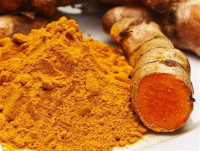Curcumin and Fluconazole to Resolve Fluconazole-resistant Candida albicans Infection in HIV Patient http://www.doi.org/10.26538/tjnpr/v6i12.5
Main Article Content
Abstract
In the last decade, there has been a significant increase in antifungal resistance against C. albicans. Curcumin is a choice of a novel therapy that is currently developing because curcumin is an agent that can affect epigenetics. Epigenetic factors significantly affect the expression of drug efflux transporter proteins, one of which is Cdr1p. This protein is encoded by CDR1. This research aimed to show documentation that curcumin overcomes Candida albicans resistance through Candida drug resistance protein (Cdr1p) expression and CDR1 methylation. C. albicans from HIV patient's oropharyngeal isolates were observed by molecular (SDS PAGE, DNA sequence analysis), colony growth, and MICs (Minimum Inhibition Concentrations) of Fluconazole and Curcumin combination. The MICs of compounds for C. albicans strains were determined using the tube dilution test by the CLSI microdilution reference method. The endpoint may be read spectrophotometrically. Colony growth was assessed by staking 0.001 ml of dilution into an agar plate. Yeast DNA isolation using Zymo Research Quick DNA Fumgal Miniprep Kit No. D6005, followed by Bisulfite treatment, Polymerase Chain Reaction (PCR), and CDR1 sequences. The most significant decrease in MICs in the C. albicans colony occurs for a combination of Fluconazole and Curcumin with a value of 6.25+ 12.5 μg/ml. Cdr1p expression for the curcumin group and the combination of fluconazole plus curcumin group was much lower than other groups, but CDR1 silencing was higher. Thus, combining curcumin with fluconazole has synergized to resolve fluconazole resistance through CDR1 silencing and decreasing Cdr1p expression.
Downloads
Article Details

This work is licensed under a Creative Commons Attribution-NonCommercial-NoDerivatives 4.0 International License.
References
Elizabeth LB and Shawn RL. Fluconazole resistance in Candida species: a current perspective. Infect Drug Resist. 2017; 10: 237–245.
Chakrabarti A. Drug resistance in fungi – an emerging problem. Regional Health Forum. 2011; 15(1):97-103.
Martins CVB, da Silva DL, Neres AT, Magalhães TFF, Watanabe GA, Modolo LV, Sabino AA, de Fátima A, de Resendeet MA. Curcumin as a promising antifungal of clinical interest. J Antimicrob Chemother. 2009; 63(2):337-339.
Moghadamtousi SZ, Kadir AH, Hassandarvish P, Tajik H, Abubakar S, Zandi KA. Review on Antibacterial, Antiviral, and Antifungal Activity of Curcumin. Cairo: Hindawi Publishing Corporation. BioMed Res Int. 2014; 1-12.
Fadus MC, Lau C, Bikhchandani J, Lynch HT. Curcumin: An age-old anti-inflammatory and anti-neoplastic agent. J Trad Complement Med. 2016; 7(3):339-346.
Sharma M, Manoharlal R, Negi AS, Prasad R. Synergistic anticandidal activity of pure polyphenol curcumin in combination with azoles and polyenes generates reactive oxygen species leading to apoptosis. FEMS Yeast Res. 2010; 10(5):570–8.
Martinez L and Falson P. Multidrug resistance ATP-binding cassette membrane transporters as targets for improving oropharyngeal candidiasis treatment. Adv Cell Mol Otolaryngol. 2014; 2:23955.
White TC, Marr KA, Bowden RA. Clinical, cellular, and molecular factors that contribute to antifungal drug resistance. Clin Microbiol Rev. 1998; 11(2):382–402.
Casalinuovo IA, Di FP, Garaci E. Fluconazole resistance in Candida albicans: a review of mechanisms. European Rev Med Pharmacol Sci. 2004; 8:69-77.
Cannon RD, Lamping E, Holmes AR, Niimi K, Baret PV, Keniya MV, Tanabe K, Niimi M, Goffeau A, Monk BC. Effluxmediated antifungal drug resistance. Clin Microbiol Rev. 2009; 2(2):291–321.
Clinical and Laboratory Standard Institute. Reference Method for Broth Dillution Antifungal susceptibility Testing. Third Edition. April 2008
Rawal MK, Banerjee A, Shah AH, Khan MF, Sen S, Saxena AK, Monk BC, Cannon RD, Bhatnagar R, Mondal AK, Prasad. R Erratum: Newly identified motifs in Candida albicans Cdr1 protein nucleotide binding domains are pleiotropic drug resistance subfamily-specific and functionally asymmetric. Sci Rep. 2016; 6:30221.
Prasad R, Banerjee A, Khandelwal NK, Dhamgaye S. The ABCs of Candida albicans multidrug transporter Cdr1. Eukaryot Cell. 2015; 14:1154-1164.
Metere A and Graves CE. Factors Influencing Epigenetic Mechanisms: Is There A Role for Bariatric Surgery?. High Throughput. 2020 Mar 20; 9(1):1-6.
Wright GD. The antibiotic resistome: the nexus of chemical and genetic diversity. Nat. Rev. Microbiol. 2007; 5:175-186.
Kumar A, Dhamgaye S, Maurya IK, Singh A, Sharma M, Prasad R. Curcumin targets cell wall integrity via calcineurin-mediated signaling in Candida albicans. Antimicrob Agents Chemother. 2014; 58(1):167–175.
Gow H. The role of chitin in C. albicans: Cell wall, commensalism and infection Importance of the Candida albicanscell wall during commensalism and infection. Curr Op Microbiol. 2012; 15:1–7.
Weig M and Muller FM. Synergism of voriconazole and terbinafine against Candida albicans isolates from human immunodeficiency virus-infected patients with oropharyngeal candidiasis. Antimicrob. Agents Chemother. 2001; 45:966–8.
Nishi I, Sunada A, Toyokawa M, Asari S, Iwatani Y. In vitroantifungal combination effects of micafungin with fluconazole, voriconazole, amphotericin B, and flucytosine against clinical isolates of Candida species. J. Infect. Chemother. 2009; 15:1–5.
Guo N, Wu X, Yu L, Liu J, Meng R, Jin J, Lu H, Wang X, Yan S, Deng X. In vitro and in vivo interactions between fluconazole and allicin against clinical isolates of fluconazole-resistant Candida albicans determined by alternative methods. FEMS Immunol Med Microbiol. 2009; 58:193–201.
Guo Q, Sun S, Yu J, Yu J, Li Y, Cao L. Synergistic activity of azoles with amiodarone against clinically resistant Candida albicans tested by chequerboard and time–kill methods. J Med Microbiol. 2008; 57:457-462.
Békési A and Vértessy BG. Uracil in DNA: error or signal?. 2015. Available from http://www.scienceinschool.org/2011/issue18/uracil. (Accessed 2017 March 5)
Rana AK and Ankri S. Reviving the RNA World: An Insight into the Appearance of RNA Methyltransferases. 2016. Available from
http://journal.frontiersin.org/article/10.3389/fgene.2016.00099/full. (Accessed 2017 March 5)
Link A, Balaguer F, Shen Y, Lozano JJ, Leung HE, Boland R, Goel A. Curcumin modulates DNA methylation in colorectal cancer cells. PLOS One. 2013; 8(2):1-13.


